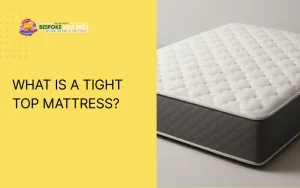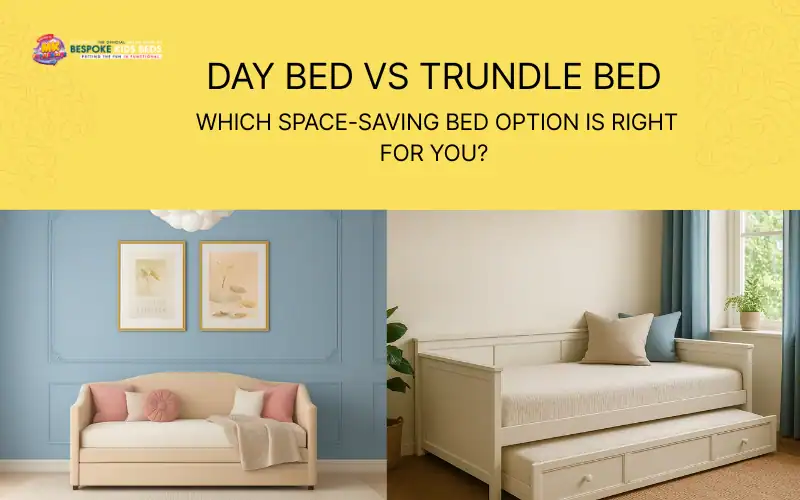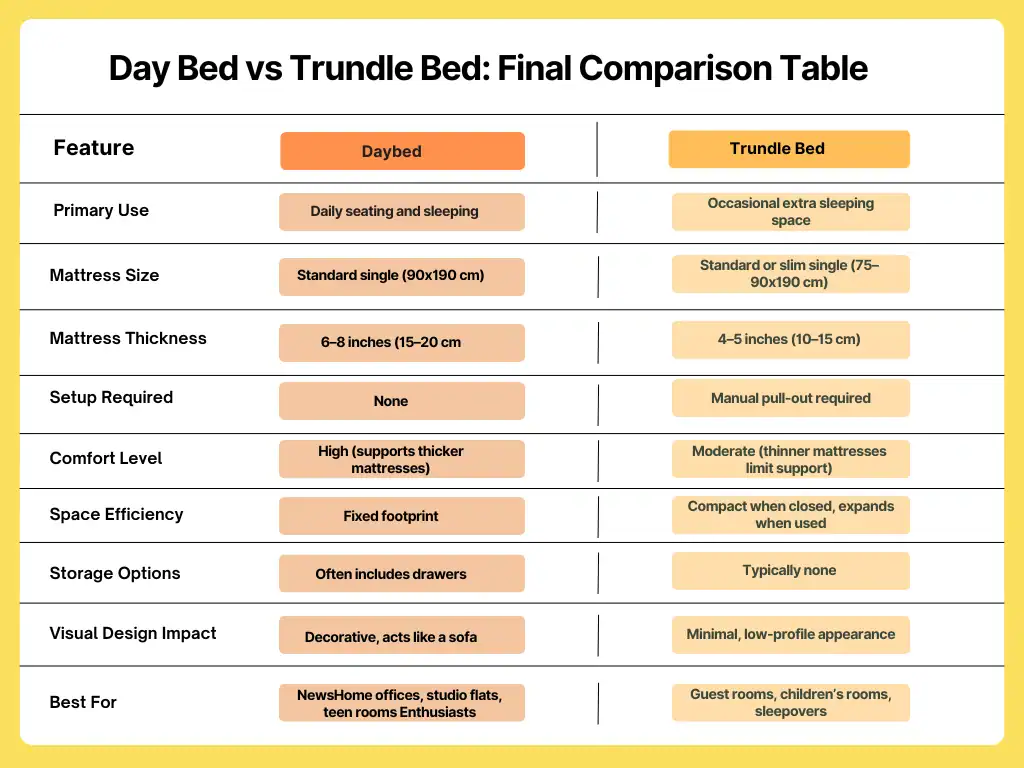
What is a Tight Top Mattress?
A tight top mattress is a mattress with a flat, even surface where the top fabric panel is tightly stitched to the side panel, creating
Enjoy FREE Delivery on All Orders!

A day bed serves as a stylish seat by day and a single bed by night, while a trundle bed offers a hidden pull-out mattress for instant guest accommodation. Both are smart, space-saving solutions, but they function differently and suit different needs.
If you are furnishing a small bedroom, guest room, or multipurpose space, choosing the right bed matters. A day bed works well as a cosy sitting area during the day and transitions easily into a bed at night. It’s a great option for rooms that need to serve multiple purposes, such as a home office that doubles as a guest space. On the other hand, a trundle bed hides a second mattress underneath, making it perfect for hosting sleepovers or accommodating guests when needed without taking up extra floor space full time.
In the sections that follow, we will compare both types of beds across essential factors like room layout efficiency, functionality, comfort, and design appeal, giving you the clarity to choose the most practical and stylish solution for your home.
A daybed is a multifunctional piece of furniture designed to serve as both a sofa and a bed. Typically built around a standard twin-size mattress (90×190 cm), it features a supportive frame with a backrest and two arms, giving it the appearance of a couch while offering the comfort of a bed.
This dual-purpose design makes daybeds ideal for small spaces, such as guest rooms, studios, or home offices. Many models include slatted bases for mattress ventilation and are crafted from materials like solid wood, metal, or engineered wood. Some also offer under-bed storage, adding practicality to their compact footprint.
A trundle bed is a space-saving solution that features a second mattress stored underneath the main bed frame. Set on casters, the lower bed rolls out easily, providing an extra sleeping surface only when needed, which makes it perfect for accommodating occasional guests.
This flexible design is especially useful in children’s rooms or compact living areas. Trundle beds support single or small single mattresses (90×190 cm or 75×190 cm) and come in materials like solid wood, powder-coated metal, or engineered wood. Some trundles stay low to the floor, while others rise to match the main bed’s height for added versatility.
Daybeds and trundle beds differ in how they perform across space efficiency, usage, comfort, design, and storage versatility. While a daybed functions as a fixed sofa-bed hybrid for everyday use, a trundle bed stores a hidden mattress that slides out only when extra sleeping space is needed.
Daybeds take up consistent space and are easier to position in tight or narrow layouts. They maintain a fixed footprint, roughly matching a standard single bed, and can be placed against a wall to preserve open space. This makes them well-suited for rectangular rooms and small bedrooms.
In contrast, a trundle bed requires additional floor clearance, typically up to 100 cm, to accommodate the pull-out mechanism. While it saves space when closed, the extended layout demands planning and limits placement flexibility in smaller rooms.
The intended frequency and style of use define how each bed functions. A daybed remains ready for both sitting and sleeping without needing rearrangement, making it ideal for rooms that serve dual purposes throughout the day. Its form supports consistent, daily use.
A bunk bed with trundle and stairs, on the other hand, is purpose-built for temporary sleeping needs. It stores the second mattress under the main frame and requires manual setup, which suits occasional guest use rather than everyday reliance.
Comfort depends on mattress quality and structural support. Daybeds typically accommodate full-size single mattresses with a thickness of 6 to 8 inches (up to 20 cm), resting on slatted or metal grid bases that ensure breathability and support. This makes them suitable for regular sleeping.
Trundle beds, however, use slimmer mattresses, usually 4-5 inches thick (12 to 15 cm), to fit beneath the main frame. These thinner mattresses are acceptable for short stays but may not provide adequate support for long-term or adult use.
Visual design plays a key role in how each bed complements the room. Daybeds are crafted to resemble sofas, featuring exposed frames that contribute to the room’s style. They come in various finishes such as painted wood, powder-coated steel, or upholstered panels, adding decorative value even when not in use.
Trundle beds, by comparison, prioritise functionality. Their hidden design reduces visual bulk, which helps them blend into minimalist interiors but offers less impact as a decor element. Still, exploring different trundle bed ideas can show creative ways to style them so they contribute both to practicality and aesthetics.
Storage capacity varies significantly between the two bed types. Daybeds often include under-bed drawers or compartments, making them ideal for storing bedding, clothing, or toys in smaller rooms. This additional functionality enhances their appeal for everyday use.
With the single and double trundle bed, the underframe is designed to hold a pull-out mattress rather than storage. This makes it excellent for increasing sleeping capacity, but less effective for room organisation.
Daybeds work especially well in spaces that need to serve more than one function throughout the day. They offer consistent utility with no need for daily setup, making them a convenient solution for rooms that double as guest spaces or lounges. However, their fixed structure and single-sleeper size may not be suitable for every layout or user.
Pros:
Cons:
Trundle beds are a practical choice for homes that need extra sleeping space occasionally but prefer to keep the room clear day-to-day. They help maximise floor space by hiding the second mattress under the main bed frame, making them ideal for children’s rooms or guest setups. Still, they have some limitations, particularly in comfort and convenience for daily use.
Pros:
Cons:
Use a daybed for a home office or studio flat where you need everyday seating and a ready-to-use bed, and choose a trundle bed for a child’s room or spare room where extra sleeping space is needed occasionally. The best option depends on how frequently the space is used and how flexible it needs to be.
Choose a daybed if:
Choose a trundle bed if:

| Feature | Daybed | Trundle Bed |
| Primary Use | Daily seating and sleeping | Occasional extra sleeping space |
| Mattress Size | Standard single (90×190 cm) | Standard or slim single (75–90×190 cm) |
| Mattress Thickness | 6–8 inches (15–20 cm) | 4–5 inches (10–15 cm) |
| Setup Required | None | Manual pull-out required |
| Comfort Level | High (supports thicker mattresses) | Moderate (thinner mattresses limit support) |
| Space Efficiency | Fixed footprint | Compact when closed, expands when used |
| Storage Options | Often includes drawers | Typically none |
| Visual Design Impact | Decorative, acts like a sofa | Minimal, low-profile appearance |
| Best For | Home offices, studio flats, teen rooms | Guest rooms, children’s rooms, sleepovers |
As we come to the end of this comparison, it’s clear that both daybeds and trundle beds have their place depending on your needs. A daybed doubles up as seating and a sleeping area, often with useful built-in storage, making it a versatile choice for everyday living. A trundle bed, by contrast, stays neatly tucked away until needed, offering a simple solution for guests or sleepovers.
At MK Furnishings, our collection of space-saving beds is designed to combine practicality with timeless design. Whether you need a versatile daybed or a convenient trundle, we make it simple to maximise your space without compromising on comfort or style. With expert craftsmanship, UK-wide delivery and flexible payment options, the right solution is just a click away. Shop now to find the perfect fit for your home.
No, a day bed and a trundle bed serve different purposes and have distinct structures. A day bed is a fixed piece used for sitting and sleeping, while a trundle bed includes a hidden pull-out mattress used for occasional extra sleeping space.
Yes, a daybed is suitable for daily use if paired with a proper mattress and supportive base. It offers the same dimensions as a standard single bed (90×190 cm), making it suitable for children, teens, or adults in compact bedrooms or studio apartments. It is a practical solution where space and functionality need to work together without compromise.
The main difference is that a daybed is always ready for use, while a trundle bed requires pulling out a second mattress. Daybeds offer fixed functionality for sitting and sleeping, whereas trundle beds provide extra sleeping space only when needed, keeping the second mattress hidden underneath.
A trundle bed is better if the room needs to stay open most of the time and only occasionally hosts guests. It keeps extra sleeping space hidden until required. A daybed is a better option if the space is used regularly for both lounging and overnight stays.
A trundle bed is generally suitable for children aged two and above. The low height makes it safe and easy for young children to climb in and out independently. It is a great option for siblings, sleepovers, or transitioning toddlers to their first bed, though the thinner mattress may not offer enough support for adults or regular long-term use.
No, most trundle beds do not come with both mattresses included by default. Typically, the bed frame is sold on its own, and in some cases, only the top mattress is part of the package. The lower pull-out mattress usually needs to be purchased separately to allow flexibility in size and thickness based on the under-bed clearance. It is important to review the product details carefully to understand exactly what’s included before ordering.
Kyle Kane
Owner
Kyle Kane is Co-Owner of MK Furnishings, a family-run business based in UK that specializes in high-quality custom kids’ bunk beds, including triple, double, single, and themed designs. Since launching the company in 2016 alongside his brother-in-law, Kyle has helped deliver and assemble thousands of beds across the UK, Ireland, and beyond. Focused on customer satisfaction, Kyle leads a hardworking team that handles every step from ordering to delivery ensuring a smooth and professional service. His commitment to quality craftsmanship and reliable support has earned MK Furnishings a strong reputation and growing customer base throughout the region.

A tight top mattress is a mattress with a flat, even surface where the top fabric panel is tightly stitched to the side panel, creating

Certifications like Greenguard Gold, National Bed Federation Certification, and CertiPUR US serve as verified approvals that help buyers identify mattresses that are safe and healthy
Fancy £50 off all orders! Enter in 50off to redeem in the coupon code section